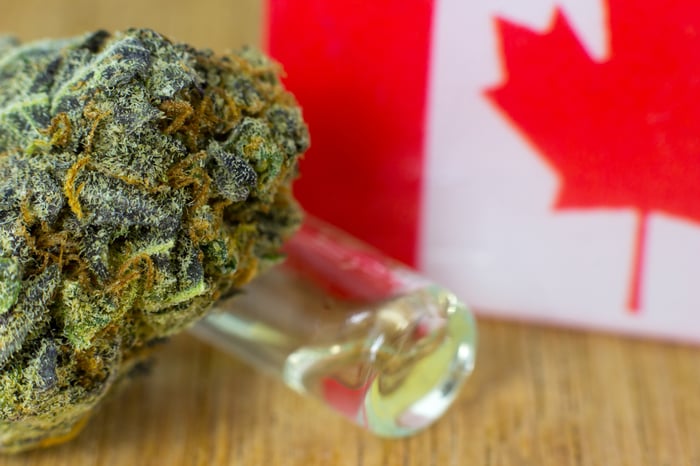It's pretty incredible what a difference a year can make.
At this time last year, cannabis stocks were flying high, and the expectation had been that most brand-name companies would push toward recurring profitability by the end of the year. Of course, hindsight being what it is, we know this didn't happen. High tax rates in select U.S. states, persistent supply issues in Canada, and a resilient black market weighed heavily on the cannabis industry in 2019 and pushed a number of popular pot stocks to two-year lows.
However, there may be light at the end of the tunnel.

Image source: Getty Images.
Canadian weed sales just hit a monthly milestone
Late last week, Statistics Canada released its monthly retail trade sales data for November. Since the marijuana industry is tightly regulated, but nonetheless legal, licensed cannabis store data is included in this monthly report. Aside from the fact that cannabis sales hit a new all-time high in November -- something not unexpected given that the Canadian pot industry is still ramping up -- what really stood out is that monthly sales finally eclipsed $100 million (that's U.S. dollars).
Here's a snapshot of how licensed cannabis store sales have progressed since adult-use weed hit dispensary shelves on Oct. 17, 2018 (data is reported in Canadian dollars (CA$), with parenthesis featuring U.S. dollar equivalency).
- October (2018): CA$53.68 million ($40.83 million)
- November (2018): CA$53.73 million ($40.87 million)
- December (2018): CA$57.34 million ($43.61 million)
- January: CA$54.88 million ($41.74 million)
- February: CA$51.66 million ($39.29 million)
- March: CA$60.94 million ($46.35 million)
- April: CA$74.58 million ($56.73 million)
- May: CA$85.81 million ($65.27 million)
- June: CA$91.46 million ($69.56 million)
- July: CA$107.36 million ($81.66 million)
- August: CA$125.95 million ($95.8 million)
- September: CA$122.93 million ($93.5 million)
- October: CA$128.98 million ($98.1 million)
- November: CA$135.75 million ($103.25 million)
It took more than a year, but November featured more than $103 million in sales for Canada, a market that Wall Street foresees generating $5 billion in annual sales by 2024. As a whole, the Canadian marijuana market has generated $916.6 million in revenue since sales commenced on Oct. 17, 2018. This makes it very likely that Canada surpassed $1 billion in aggregate pot sales since launch in December, but we'll have to wait a month to confirm.

Image source: Getty Images.
Here's why Canadian cannabis sales could make a major leap forward in 2020
The hope, among both Wall Street and investors, is that this uptick in sales is really just the tip of the iceberg. Two key changes in the cannabis market are expected to improve consumer demand and relieve a lot of the supply bottlenecks that've hindered pot sales to this point.
The first is the launch of high-margin derivative products, which kicked off in mid-December. Derivatives are non-dried flower products, such as vapes, edibles, infused beverages, topicals, and concentrates. Not only do derivatives offer a new means of consumption that doesn't, necessarily, require smoking cannabis, but they're significantly more attractive to a younger generation of users who have shown a greater willingness to try or buy these higher-margin consumption alternatives.
According to investment bank Cowen Group, half of all U.S. pot sales are expected to be generated from derivatives, with dried flower and pre-rolled cannabis making up the other 43% and 7%, respectively. If these figures translate similarly in Canada, then the launch of derivatives should begin to put some pep in grower's step by midyear, or maybe even sooner.
The other major catalyst is the long-awaited dispensary license reform being undertaken in Ontario, the country's largest province by population. Having previously worked with a lottery system, Ontario, home to 38% of Canada's residents, only opened 24 cannabis retail stores as of the one-year anniversary of recreational weed sales. This created few channels for legal product to reach consumers and allowed the black market to thrive.
Moving forward, Ontario has plans to issue dispensary licenses in a more traditional fashion. Licenses should start being issued by no later than April, with the expectation of 20 (or more) stores opening each month. By year's end, provincial regulators hopes to have around 250 open locations, representing about a 10-fold increase from where it began the year.

Image source: Getty Images.
Marijuana stocks may not be so quick to benefit
On the other side of the coin, while sales are expected to march higher in 2020, there's no guarantee that we're going to see an immediate benefit to pot stocks. While higher revenue and improved margins via the sale of derivatives is a good thing, there's no assurance that we'll see meaningful progress in the bottom lines of pot stocks, which is what matters most.
For instance, Aurora Cannabis (ACB 12.87%) has been a highly popular marijuana stock to this point. It was touted as the leading producer, a company with the broadest international presence, and a practical shoo-in to land a brand-name partner given that it hired activist investors and billionaire Nelson Peltz as a strategic advisor.
Yet, in recent months we've seen Aurora Cannabis put its Exeter greenhouse up for sale, as well as completely halt construction on its massive Aurora Nordic 2 project in Denmark and Aurora Sun campus in Alberta. What had been a steadfast prediction that called for at least 625,000 kilos of run-rate output by mid-2020 now looks to be no more than 225,000 kilos, at best.
Aurora Cannabis is also encountering the same issue as Canopy Growth (CGC 20.65%) and Tilray -- namely, that expanding internationally isn't paying any immediate dividends. Despite Aurora, Canopy, and Tilray having a presence in 24, 16, and 12, respective countries outside of Canada, many of these medical marijuana-legal markets are either still establishing their regulations or aren't ready to commit to large imports as of yet. Additionally, Health Canada is counting on its growers to satiate domestic production first before exporting abroad.
And, of course, balance sheets for brand-name cannabis stocks remain a mess. Aurora Cannabis and Canopy Growth are both lugging around an inordinate amount of goodwill that stems from a number of overpriced acquisitions. Aurora Cannabis is also contending with fears that it may not have enough capital on hand to pay off its existing debt.
Things may be improving for the Canadian pot industry as a whole, but individual marijuana stocks remain a dicey investment opportunity.





